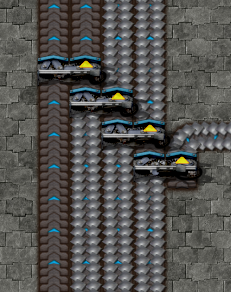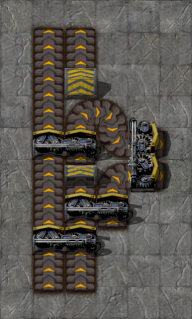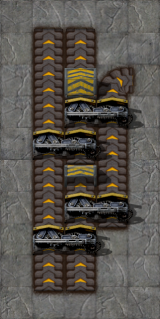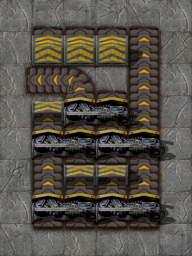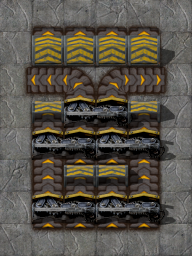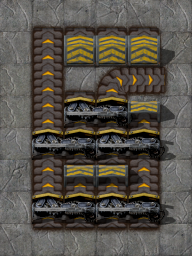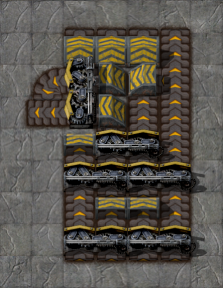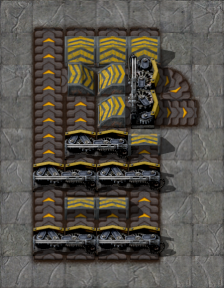User:Fried biter/workspace2: Difference between revisions
Fried biter (talk | contribs) m (Copied Solid_fuel from special:PermanentLink/151500) |
Fried biter (talk | contribs) mNo edit summary |
||
| (29 intermediate revisions by the same user not shown) | |||
| Line 1: | Line 1: | ||
{{Languages}} | |||
[[File:main_bus.jpg|thumb|400px|メインバスが、いくつかの異なるアイテムや中間生成物に利用されている。]] | |||
<!-- alternate first sentence: The concept of a '''Main bus''' is the order and central distribution of materials to assembling machines. --> | |||
'''メインバス(Main Bus)'''の概念は、組立機で最も利用され、また利用価値のある原料を中核に据えるもの。 | |||
これにより構造化された配置が強制され、利用するアイテム全てをバスから引っ張り出すしかなくなるため、「スパゲッティ工場」と格闘する良い手段となる。 | |||
これらは同時に欠点でもあり、より多くのベルトを使用するし、よってベルトのバッファにより多くのスペースを使用するのでコンパクトさからは程遠い。 | |||
バス構造を利用するかどうかはしばしば、マップ開始時や、最初に炉を並べるときに決定される。 | |||
バスはよく、鉄、銅、鋼の精錬から始まり、時間と距離が離れるほどにより多くの異なったアイテムを含むようになる。 | |||
ベルト(分岐先があればそれも)が飽和するほどの生産量を確保できない場合、飽和''しない''それらは「偽」バス("fake"-bus)と呼ばれる。 | |||
''' | 特に、アイテムが止まってしまい、ベルトが一見運べそうに見えるだけの量を運べないせいで全てのベルトがいっぱいになっている場合は騙されやすい。 | ||
後の拡張に備えた空間のせいでこうなることもある。この場合ブループリントの仮設置が便利で、ベルトが利用不能なアイテムで一杯になることを防げる。 | |||
バスの方向が垂直か水平かは個人の好みで、十中八九後から利用拡大のために拡張することとなるだろう、分かれた生産部をどう動かすかによる。 | |||
向きごとにプレイヤーが監視できる幅もまた、この決定に影響する。 | |||
曲がり角の存在が許されないわけではないが、殆ど見られない。大概の場合、予定外の池が出てきたときくらいにしか使わないだろう。 | |||
== | == 内容物 == | ||
どのアイテムをバスに置くかは個人の好みだ。 | |||
いくつかのアイテムは、「オンサイト(on-site)」で、つまりバスで運ぶのではなく必要となる場所で作ったほうがよいだろう。 | |||
いい例としては[[copper cable/ja|銅線]]が挙げられ、銅板として運ぶよりかさばってしまう。 | |||
以下に上げるのは、過去の人々がそのバスに置いてきた物々。 | |||
* [[Iron plate/ja|鉄板]]用のいくつかのベルト。だいたい4の倍数本。[[underground belt/ja|地下搬送ベルト]]で潜れるのが4マスなので。 | |||
* 同様に、[[Copper plate/ja|銅板]]用のいくつかのベルト。だいたい鉄板よりは少なく。0.15現在、とても少なく。 | |||
| | * [[Iron gear wheel/ja|鉄の歯車]]もそれなりにバスで見られる。0.15現在、鉄板の半分のスペースしか取らず(より密度が高く)、多くのレシピで利用されるため。 | ||
| | * [[Electronic circuit/ja|電子基板]]とその後も | ||
| | * [[Advanced circuit/ja|発展基板]]は高速に使い切られてしまうものの、多くの異なった製品で利用されるわけではないのでいうほど必須ではない。 | ||
| | * [[Steel plate/ja|鋼材]]。 | ||
| | * [[Processing unit/ja|制御基板]]は、上述した他の中間生成物よりずっと少ないレシピでしか利用されないのでバスには殆ど見られない。 | ||
| | * [[Battery/ja|電池]]。 | ||
* [[Plastic bar/ja|プラスチック棒]](場合によっては、プラスチックが製造される場所から[[coal/ja|石炭]]と入れ替わりで)。 | |||
どのアイテムも、そのアイテムが必要になったときに引き出せるように専用ベルトを持つ。 | |||
バスに流体パートを設ける人もいる。例えば以下のようなもの。 | |||
* 制御基板用の[[Sulfuric acid/ja|硫酸]]。 | |||
* [[concrete/ja|コンクリート]]用の[[Water/ja|水]]。 | |||
* [[express transport belt/ja|超高速搬送ベルト]]用の[[Lubricant/ja|潤滑油]]。 | |||
== アドバイスと制限 == | |||
Having all possible items on a bus results in a huge wide bus with a lot of belt-buffer for expensive items and standing belts of output-items that wont get used in another process. | |||
These items are often just put into [[chests/ja|チェスト]] for personal use rather than on a bus. | |||
The width of the bus can become a problem if it is very wide. | |||
Players sometimes choose to only build on one side of the bus until they can estimate that they wont need more belts on the bus. | |||
It is advisable to leave ''space'' between the groups of belts of one item for underground belt to surface and for other things to cross the bus. | |||
A recommended numbers is two free spaces for every group of four belts, although leaving more space can be useful too. | |||
Same with the production that is to the side of the bus, leave space ''between the builds'' for later expansion or belts that go between, at least three, six to ten is fitting. | |||
Grouping differing items together can cause problems when splitting them off, hence only groupings of two differing items is recommended. | |||
Having smaller groups of only one or two is also not a bad thing. | |||
When [[logistic robot/ja|物流ロボット]]s are available one might start moving some items by robots instead of using the bus. | |||
Some players eventually phase out the main bus entirely in favor of robots. | |||
This may happen at a later stage in the game up to which a bus is a very good tool to reduce clutter. | |||
But robots have their own difficulties and require a lot more resources and knowledge of the game. | |||
For very large amounts of items [[railway/ja|鉄道技術]]s may be a better alternative that can not only carry large amounts of ore but also the intermediate and end-products. | |||
This can lead to designs of a base consisting of only train-stations with small [[logistic network/ja|物流ネットワーク]]s without any belts. | |||
For a comparison of belt, logistic robot and railway transport systems, refer to the [[Tutorial:Transport_use_cases/ja|Transport use cases tutorial]]. | |||
One [https://redd.it/5gn30r reddit post] mentions the use of [[cargo wagon/ja|貨物車両]]s as a means to increase throughput and reduce the size of a bus. | |||
== | == 分離 == | ||
When one wants to use the items on their bus one could directly take items off the bus as if it is just a belt, though that would mean an extremely long bus and useless lengths of other belts. | |||
This is sometimes done to get Items crafted into a chest for personal use like [[pipe/ja|パイプ]] which only uses Iron plates. | |||
However in most cases a belt is split away from the main bus that can deliver the resource to the factory. Split-off designs aren't strictly necessary but help immensely. The following designs have the additional property that if the incoming belts are fully saturated then the split-off belt will be full (recall that a single splitter with a single full input belt will by default split off a half-filled belt). | |||
With [[splitter/ja|分配器]] priorities that were added in 0.16 it is very simple to split off a belt from a main bus while ensuring good throughput properties. The design shown here makes sure that the belts on the right side are filled first, so belts can be taken from the right every time without the need to further rebalance. Thus up to a full belt can be delivered and the remaining resources can go through on the main bus. | |||
[[File:4-split-priority.png]] | |||
- | Alternatively, one can make split-off setups without priority splitters. The idea is that one wants to draw from every belt (and lane even) equally to not have too few items at the current planned production and not have empty and at the same time standing belts of items. | ||
That way at every step along the bus a few items are split off and used up and when the production comes to a stop the items go on to be used by the next production. | |||
The following are 2 designs for a split-off off a 2-wide bus (by reddit user [https://www.reddit.com/user/unique_2 /u/unique_2]). | |||
<gallery mode="nolines" widths=224px heights=320px > | |||
File:2-split_variant_a.png|{{BlueprintString|bp-string=0eNqVld9ugyAUxl/FnKstwRbwT1sfY7fL0mhLHIlFh9DMGN99qO1mWrrCFfHI9+NwvgP0UFSaNZILBVkP/FCLFrL3HlpeirwaY6prGGRw5lJpE0Eg8tMYmGeEFAYEXBzZN2RkQB7Kt4WSWpVcsdNC1lRcKSYXsshBpmQu2qaWKixYpRbiePhAwITiirN509NHtxf6VJhlMvKIgaCpWyOrxbiqQYUUQWeGeBgTusFQdwz5BxN5ZxPZMLE3htowiTMGXykIjlyyw/wrtjBT70LdQKkFuvmFamO7LGVtxidY01bXXqq1avTYNXfgrW8hsa2Ou/v2tqS1SubEiA1BsKcX+HnVCPH1lzhAqb8X+M8KLh44QSKHIl6sxavEIVHvQ2I3JvEx13rMSOqCwBeEPYuN72as9wbZ+p5OgzEX7HQZZ4tnBkGVG52J0XDaUyB5+amCl6IL1nqtBf/SbE9fg9xMPTPZTuA0jmmabiihu2H4AQXcOK0=}} | |||
{{ | File:2-split_variant_b.png|{{BlueprintString|bp-string=0eNqVlNFugzAMRX8F+WmTwkpSSlc+Y6/TVEEbdZZoYMGphir+fYZOHVrTijwhQu7J9Y3xGcrK6caiIcjPgLvatJC/n6HFgymqYY26RkMOJ7TkeEWAKY7DwmVHrKAXgGavvyGXvQhQvk2UyqtE0seJrKmQSNuJbDlDRrYwbVNbiktd0USc9h8CtCEk1Jeix5dua9yx5GNyeY8hoKlbltVmOJVRMW/t+JH2g6F/GDUbkzygLIPNLH2YNBijfJjVbMzVjIA9Wr27fFIeZnZ707cJvaweuFpfCY6v2B5szc/HWQ++ftumdtS4oUFuuK+hoSU+d5sZ9cXXAqUPIZPA3L1GpAy9Pb8ZFRx38pc2mjthy+BO97tLQ+L2tpNcBXSk30QWWov3p5XrwBHCFJ5t4xzMJxNeQFWwjNdUPFYUWTx8UvRUdtHCLZzBL6e36jkqeetJ23bkZmmqsmytpNr0/Q+uzw2D}} | ||
</gallery> | |||
Putting a lane-balancer after a split-off is not necessary most of the time as the rest moves on if the belt has no draw or if only one lane is used. | |||
If there is enough input for the item to saturate a whole belt then putting a lane-balancer in wont help to get more items later on. | |||
Putting a lane-balancer after an inherently balanced build that produces the item is also not necessary as then half of the production pauses and the other half fills the moving lane to saturation. | |||
The following is a split-off off a 4-wide bus. | |||
== | <gallery mode="nolines" widths=224px heights=256px > | ||
File:4-split_l.png|{{BlueprintString|bp-string=0eNqlld1qhDAQhV+lzHUsxv/6DPsGpRTdDUvAjRLjUhHfvaPWVTBbMu1VcPR8OTOTMQOUVScaLZWBfAB5rlUL+fsArbyqoppipm8E5HCX2nQYYaCK2xRYvvAiGBlIdRFfkPOREZSnnTKwKqURt01mdKHaptbGK0VlduLwP+Jo/GAglJFGiiX1+aH/VN2tFBqTejA6VOirrnFdKAyaukVhraZ9EeYFDHpc0NFqo+5M000bHsABAewTuCHFMCeAo2fVPGAfVAsl/kM9+WZPqifuEmd3KxUPHVykFuflXWKBpu5Q7gzNtkloKmkMxo44/zVec7cg3qitCGwU7lMxVjOcuyTEfxLyrYiA2j27k9DBif+rkYg8lS6Hk8f0oXTiJsQO2suWUhpoP0oZofJIwJ/u/IPOdxcQg6pA7xiLvBnyMl0ad6HbZZSyNOBZmPhhNI7frCw6ag==}} | |||
File:4-split_lr.png|{{BlueprintString|bp-string=0eNqdld9qgzAUxl9lnOs4TBq19Rl6tdsxhrahBGyUGMuK+O476jqFxpGzq+DR75fv/DHpoaw61VhtHOQ96FNtWsjfe2j1xRTVGHP3RkEON21dhxEGpriOgfmLSMLAQJuz+oKcD8yj1E5dF5mzhWmb2rqoVJVbiYVXvLXtcaXckZRvK6UcPhgo47TTas57erh/mu5aKosZ/ao7VNiLrXGdnTNo6haFtRk3RVgkGNxxQTsPD3Xnmm5M8gksCOCYwN1RDHMCWBLAFG7yjwrzBazNBjfdmrhNKg4gnLVVp/ld6oFmwdDYyxQe5j7cKA82elimvqm0cxh7xsWvyaOeHgSP6R0PaQznwQnz4CJyEZIw/0k49ua7o06Mv2wywEn8p5GEfDYE1T2lHw1B3IzYT3/Z9pQGCi/iQKg8EvDon66mfHUHMqgK9I4xGU2Ql2qE3JRt539NSpGmmeDiMAzfI+ZmDA==}} | |||
| {{ | |||
= | File:4-split_r.png|{{BlueprintString|bp-string=0eNqlldFugzAMRX9l8nOYcEih5TP2Ok0TbaMqEgQUQjVU8e8LdAy0hirWniIM9+TajsMNjmUnG6O0hfwG6lTrFvL3G7TqootyjNm+kZDDVRnbuQgDXVRj4P5FJGBgoPRZfkGOAyMo31ZK7lUqK6tFZk2h26Y2NjrK0q7EyX/EYvhgILVVVsl76tND/6m76iiNS2qLwaCpWyer9birQ0WcQe+WZBgN/cHwX0znNjYXU7t1AxTPHDYnU3e26UbbD9yEwI2QABYEMIW7I9eT++qZkjHow2TBmHg2w+CsjDzdX3EPc7+c9KZU1rrYo6n4dffE1iHYFgbbwpjeUVw6qvRGQxFD8sWffGNfusip3fRWDZMAJ/FTI4I8pkEl2tGnNIibEs+Jv2wZpYHeacQ9ofKO4O7c6X7OV/8fBmXhvLuYiCbIy8i4StNOiFQInqYZR34Yhm/sYzpB}} | ||
</gallery> | |||
Taking two belts off of this wont produce two belts worth of output, the middle one only carries ''half a belt'' to each side! | |||
As of 0.16 Splitters can prioritize one in- and output lane, therefore the above design can supply fully saturated belts, if the splitters are set up in a way that prioritizes the output belt (to earlier production) rather than letting items go on. | |||
The following are two designs for a split-off off a 4-wide bus that feature an in-line lane-balancer(by reddit user [https://www.reddit.com/user/moomaka /u/moomaka]). | |||
<gallery mode="nolines" widths=224px heights=288px > | |||
File:4-split_l_lane.png|{{BlueprintString|bp-string=0eNqVllFugzAMhq9S5WmToCUh0JYz7AbTNEGbVdEgQSFUQxV3n4ExsTVs8VOEyf/Z2I7DjRRlK2ojlSXZjciTVg3Jnm+kkReVl4PNdrUgGblKY1uwBETl1WCYdoSc9AGR6iw+SEb7AKF8WiiZUymtqBayupTWCrOQxR4ya3LV1NrYsBClXYh5/xIQoay0UkwfPT50r6qtCnCT0W9GCwpzMRrWiRKQWjcg1GrwC7AQNnewQERzGLq1dTs4vAMzBBjDjRHcCMHla8m8o7KZ6qAk3pTwCwNdQc7SiNP0jjugKRpKf0JTB3R/33OrBafb5H/gAV+Y32F6lOmI98LwXmiE795VN1KteaHehZ0L4eo5yrCty5yYGItxR8PxEyXqPZKV+DRstE1Goju01AMxEyInwefU0D9jOCCz7I7j6D8SphQ7S84iTE6dA49R9ElhHtVmDH3OvbAxon7u78XeE5B4uILH6zpb/IgEpMxBBjYejqFsSvFmNw9Ft9m1u0rrKn/PH2HbVZhmGiicszTdM8qOff8JVpvtyQ==}} | |||
= | File:4-split_r_lane.png|{{BlueprintString|bp-string=0eNqdlt1ugjAUx1/F9GpLitJDReUxdrssC2jjmkFLSjEjhndfwbkQLabHq4bC/3c+e8qZFGUraiOVJdmZyL1WDcnez6SRR5WXw57takEycpLGtm6HEpVXw8bli4iTnhKpDuKHZKynCOXbRAlepbSimsjqUlorzESWBMisyVVTa2OjQpR2Iub9ByVCWWmluAQ9PnSfqq0KZyZjcwxKat04mVaDVYeKEkq6YekHh24w8I9pnWFzNNqtcyB2BdFrNLq1dTv4fQdOMGBAgDkCHCO4a3RCmS+hKRoDPswmHAMPvNk+UV53UMhBGrG/vIOA3O2eKDbMmZFqxgqLn4gG8NGw8LPlN8J9UMBCb+vggyb3A2juELDlOgDIse0b+9qOrQP8imC5HhHezmVpCIL9IfxebEIQ8UMvtuhpE/cBnbzDptk7JCDGpNk//xn+TEFAhAD4kRDETTA19Ycc3uPxNffuMh4v7mzyS0JJmTuZ2+PR6MvCyOOXXbwU3WLVriqtq/w7f3XfnYRpRmjKOaTpBhjs+v4XLT/v+g==}} | ||
</gallery> | |||
The way in which materials are split off from the main bus determines which production setups in the factory are prioritized if the bus delivers less input than all the setups combined need. | |||
The split-offs shown above generally prefer setups near the start of the main bus but will also supply some limited materials to the later setups. | |||
There are alternative designs, for example using [[splitter/ja|分配器]] priorities on can fully prefer the setups near the start of the main bus and only allow materials to go through to a later setup if that earlier setup's needs are satisfied. | |||
The priorities can be set in various ways but this should not distract from the fact that more resource input should be added whenever this becomes a concern. | |||
== | == 関連項目 == | ||
* [[Tutorial:Transport_use_cases/ja|どの輸送手段をいつ使う?]] | |||
* | * [[Belt transport system/ja|ベルト輸送システム]] | ||
* [[Logistic network/ja|物流ネットワーク]] | |||
* [[Railway/ja|鉄道]] | |||
* [[ | * [[Splitter/ja|分配器]] | ||
* [[ | |||
Latest revision as of 01:17, 11 December 2018
メインバス(Main Bus)の概念は、組立機で最も利用され、また利用価値のある原料を中核に据えるもの。 これにより構造化された配置が強制され、利用するアイテム全てをバスから引っ張り出すしかなくなるため、「スパゲッティ工場」と格闘する良い手段となる。 これらは同時に欠点でもあり、より多くのベルトを使用するし、よってベルトのバッファにより多くのスペースを使用するのでコンパクトさからは程遠い。
バス構造を利用するかどうかはしばしば、マップ開始時や、最初に炉を並べるときに決定される。
バスはよく、鉄、銅、鋼の精錬から始まり、時間と距離が離れるほどにより多くの異なったアイテムを含むようになる。 ベルト(分岐先があればそれも)が飽和するほどの生産量を確保できない場合、飽和しないそれらは「偽」バス("fake"-bus)と呼ばれる。 特に、アイテムが止まってしまい、ベルトが一見運べそうに見えるだけの量を運べないせいで全てのベルトがいっぱいになっている場合は騙されやすい。 後の拡張に備えた空間のせいでこうなることもある。この場合ブループリントの仮設置が便利で、ベルトが利用不能なアイテムで一杯になることを防げる。
バスの方向が垂直か水平かは個人の好みで、十中八九後から利用拡大のために拡張することとなるだろう、分かれた生産部をどう動かすかによる。 向きごとにプレイヤーが監視できる幅もまた、この決定に影響する。 曲がり角の存在が許されないわけではないが、殆ど見られない。大概の場合、予定外の池が出てきたときくらいにしか使わないだろう。
内容物
どのアイテムをバスに置くかは個人の好みだ。 いくつかのアイテムは、「オンサイト(on-site)」で、つまりバスで運ぶのではなく必要となる場所で作ったほうがよいだろう。 いい例としては銅線が挙げられ、銅板として運ぶよりかさばってしまう。
以下に上げるのは、過去の人々がそのバスに置いてきた物々。
- 鉄板用のいくつかのベルト。だいたい4の倍数本。地下搬送ベルトで潜れるのが4マスなので。
- 同様に、銅板用のいくつかのベルト。だいたい鉄板よりは少なく。0.15現在、とても少なく。
- 鉄の歯車もそれなりにバスで見られる。0.15現在、鉄板の半分のスペースしか取らず(より密度が高く)、多くのレシピで利用されるため。
- 電子基板とその後も
- 発展基板は高速に使い切られてしまうものの、多くの異なった製品で利用されるわけではないのでいうほど必須ではない。
- 鋼材。
- 制御基板は、上述した他の中間生成物よりずっと少ないレシピでしか利用されないのでバスには殆ど見られない。
- 電池。
- プラスチック棒(場合によっては、プラスチックが製造される場所から石炭と入れ替わりで)。
どのアイテムも、そのアイテムが必要になったときに引き出せるように専用ベルトを持つ。
バスに流体パートを設ける人もいる。例えば以下のようなもの。
アドバイスと制限
Having all possible items on a bus results in a huge wide bus with a lot of belt-buffer for expensive items and standing belts of output-items that wont get used in another process. These items are often just put into チェスト for personal use rather than on a bus.
The width of the bus can become a problem if it is very wide. Players sometimes choose to only build on one side of the bus until they can estimate that they wont need more belts on the bus.
It is advisable to leave space between the groups of belts of one item for underground belt to surface and for other things to cross the bus. A recommended numbers is two free spaces for every group of four belts, although leaving more space can be useful too. Same with the production that is to the side of the bus, leave space between the builds for later expansion or belts that go between, at least three, six to ten is fitting. Grouping differing items together can cause problems when splitting them off, hence only groupings of two differing items is recommended. Having smaller groups of only one or two is also not a bad thing.
When 物流ロボットs are available one might start moving some items by robots instead of using the bus. Some players eventually phase out the main bus entirely in favor of robots. This may happen at a later stage in the game up to which a bus is a very good tool to reduce clutter. But robots have their own difficulties and require a lot more resources and knowledge of the game.
For very large amounts of items 鉄道技術s may be a better alternative that can not only carry large amounts of ore but also the intermediate and end-products. This can lead to designs of a base consisting of only train-stations with small 物流ネットワークs without any belts. For a comparison of belt, logistic robot and railway transport systems, refer to the Transport use cases tutorial.
One reddit post mentions the use of 貨物車両s as a means to increase throughput and reduce the size of a bus.
分離
When one wants to use the items on their bus one could directly take items off the bus as if it is just a belt, though that would mean an extremely long bus and useless lengths of other belts. This is sometimes done to get Items crafted into a chest for personal use like パイプ which only uses Iron plates. However in most cases a belt is split away from the main bus that can deliver the resource to the factory. Split-off designs aren't strictly necessary but help immensely. The following designs have the additional property that if the incoming belts are fully saturated then the split-off belt will be full (recall that a single splitter with a single full input belt will by default split off a half-filled belt).
With 分配器 priorities that were added in 0.16 it is very simple to split off a belt from a main bus while ensuring good throughput properties. The design shown here makes sure that the belts on the right side are filled first, so belts can be taken from the right every time without the need to further rebalance. Thus up to a full belt can be delivered and the remaining resources can go through on the main bus.
Alternatively, one can make split-off setups without priority splitters. The idea is that one wants to draw from every belt (and lane even) equally to not have too few items at the current planned production and not have empty and at the same time standing belts of items. That way at every step along the bus a few items are split off and used up and when the production comes to a stop the items go on to be used by the next production.
The following are 2 designs for a split-off off a 2-wide bus (by reddit user /u/unique_2).
Putting a lane-balancer after a split-off is not necessary most of the time as the rest moves on if the belt has no draw or if only one lane is used. If there is enough input for the item to saturate a whole belt then putting a lane-balancer in wont help to get more items later on. Putting a lane-balancer after an inherently balanced build that produces the item is also not necessary as then half of the production pauses and the other half fills the moving lane to saturation. The following is a split-off off a 4-wide bus.
Taking two belts off of this wont produce two belts worth of output, the middle one only carries half a belt to each side! As of 0.16 Splitters can prioritize one in- and output lane, therefore the above design can supply fully saturated belts, if the splitters are set up in a way that prioritizes the output belt (to earlier production) rather than letting items go on.
The following are two designs for a split-off off a 4-wide bus that feature an in-line lane-balancer(by reddit user /u/moomaka).
The way in which materials are split off from the main bus determines which production setups in the factory are prioritized if the bus delivers less input than all the setups combined need. The split-offs shown above generally prefer setups near the start of the main bus but will also supply some limited materials to the later setups. There are alternative designs, for example using 分配器 priorities on can fully prefer the setups near the start of the main bus and only allow materials to go through to a later setup if that earlier setup's needs are satisfied. The priorities can be set in various ways but this should not distract from the fact that more resource input should be added whenever this becomes a concern.

